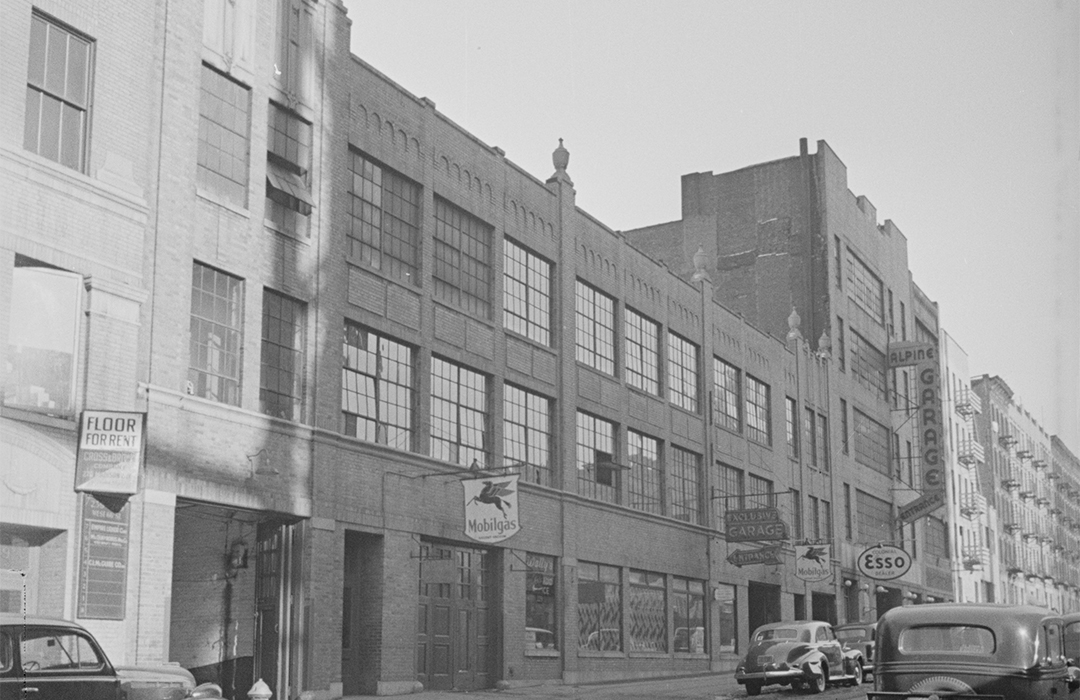
229-237 West 66th Street
by Jessica Larson
Built originally to serve as a garage, this three-story-and-basement building was briefly used as a YMCA Trade & Technical School, focused on training young men in useful manual trades. Schools such as this were a valuable avenue for working-class men to gain the skills necessary to secure a degree of financial stability in the early to mid-twentieth century.
In the early twentieth century, lots in the West 60s, particularly those closest to the Hudson River, were developed into garages to meet the needs of the new and rapidly growing car industry. This area, considered rather undesirable due to its distance from most businesses and proximity to the water, had long been used for stables; the smells and heavy use of hay–a major fire hazard in the nineteenth century –meant that anything related to horses was usually located far from heavy residential and commercial concentrations. By the early twentieth century, horses were steadily replaced by cars, and many stables in San Juan Hill were converted into garages. This was not the case with the lots at 229-237 West 66th Street, however; tenements were built on these lots, likely sometime in the 1880s under the “Old Law” tenement legislation. These were demolished and replaced by the J.M. Fleson-designed garage for the Rosebeth Realty Corporation in 1929.
Between 1945 and 1946, the building was converted for use as the YMCA Technical & Trade School. The ground floor had office space as well as room for teaching various types of electrical repair. The second story had storage space, teaching space, and bathrooms. The third story included more office space. The building was shared with commercial businesses. In 1951, the Radio Corporation of America leased part of the building to be used to service and repair television sets.
Between 1945 and 1946, the building was converted for use as the YMCA Technical & Trade School.
Many similar versions of the YMCA, wherein students learned technical and trade skills, existed throughout the country and offered different types of courses. Some focused on building trades, such as engineering and drafting; some focused on skills such as electrical repair, etc. The Young Men’s Christian Association was founded in 1844 in London in response to worries over the growing numbers of young men migrating to cities following the Industrial Revolution. YMCAs were designed to cultivate qualities of manliness, moral strength, and financial stability in these men, often painted as aimless and wayward. The first YMCA in New York City opened in 1852 in the former Stuyvesant Institute’s building at 659 Broadway. As in England, the expectation was that these would serve as centers for producing productive, upwardly mobile men.
YMCAs were both purpose-built and examples of adaptive reuse (meaning, converted from an existing structure). Purpose-built Ys were often large and elaborate, including amenities like gymnasiums, baths, reading rooms, billiard rooms, lecture halls, bowling alleys, and more. Often, ground floor space was reserved for stores as a means of generating revenue to support the Ys activities –a common architectural strategy for nineteenth and early twentieth century social reform organizations. Just nine blocks south of the West 66th Street Y was the West Side YMCA at 318 West 57th Street, which, alongside typical Y facilities, included ample space and resources for education. Classes were offered to prepare for college, technical school, and business. In 1910, the West 57th Street branch acquired the building at 40 West 66th Street, just a few blocks to the east of the YMCA Technical & Trade School, and was an instance of adaptive reuse. The 229-237 West 66th Street YMCA was more specialized and a much smaller operation.
The YMCA Technical & Trade School was an outgrowth of the Automobile School of the West Side YMCA, which was created in 1905. In 1945, the YMCA expanded to include a number of these trade schools throughout the city, including one at 5 West 63rd Street. These schools offered classes in oil burner repair, automobile mechanics, radio and television repair, plumbing, sign painting, and more. For many, this type of education offered a solid pathway towards upward mobility that was not realistic for working-class people simply attending more standard schooling. Historians, however, have criticized these systems for discouraging significant class advancement and, in many cases, targeting young Black men and trapping them in subservient professions.
YMCAs had long been segregated. For Black New Yorkers interested in patronizing one, San Juan Hill’s male residents could visit the Colored YMCA at 32 West 53rd Street. For a brief time in 1907, the Colored YWCA (Young Women’s Christian Association) rented space in St. Cyprian’s Parish House on West 63rd Street before moving to 143 West 53rd Street. Whether Black men would have been welcome at the 229-237 West 66th Street trade school is less clear-cut. In 1946, the national arm of the YMCA instructed its branches to desegregate. Whether the school still implicitly excluded Black students is certainly possible. In 1953, the Executive Director of the Bedford Branch in Brooklyn led a walkout to protest ongoing discrimination within the YMCA.
In 1957, Manhattan’s trade and technical schools merged with the Brooklyn Trade School and were relocated to the Y’s Bedford Branch. This was good timing as the West 66th Street block was marked for demolition under the Lincoln Square Renewal Project, which began in 1955 and finished in 1969.
YMCAs had long been segregated.
Resources:
“Garage is Leased for Video Service:” New York Times. Oct. 1, 1951: p. 25.
Lupkin, Paula. Manhood Factories: YMCA Architecture and the Making of Modern Urban Culture. University of Minnesota Press. 2010.
McGruder, Kevin. Race and Real Estate: Conflict and Cooperation in Harlem, 1890-1920. Columbia University Press. 2015.
The Nautical Gazette, Vol. 79, no. 1 (May 10, 1911): p. 27.
New York State Appellate Division. Records and Briefs, Vol. 12. New York. 1958.
“Phila. Polytechnic Institute Offers Wide Range of Technical Courses.” Building: A Monthly Magazine Devoted to the Building Industry, Vol. 8 (Sept. 1928): p. 14.
Radio Daily, Vol. 35 (1946): p. 1.
Sargent, Porter E. A Handbook of Private Schools for American Boys and Girls. Boston, MA. 1920.
State of New York Department of Labor. Directory of New York State Manufacturers, Vol. 1. New York. 1932.
University of the State of New York. Education Department Bulletin. New York. 1947.
Vocational Advisory Service. Vocational Training in New York City, Where to Find it. New York. 1950.
Jessica Larson is a PhD Candidate in the Department of Art History, The Graduate Center, CUNY. She is also the Joe and Wanda Corn Predoctoral Fellow at the Smithsonian American Art Museum & National Museum of American History


